All the uncertainty and unexpected changes of 2020 have forced us, and the ways we interact, to adapt. Sharing information about forest management and wildfire preparedness during covid-19 social distancing guidelines has been no exception. Some of our largest outreach opportunities typically occur at parades, in-person exhibition events, and meetings. Some Fire Adapted Communities New Mexico (FAC NM) leaders have demonstrated resilience in the face of uncertainty by finding new and creative ways to reach community members.
In response to social distancing challenges, FAC NM Leader Sean Ludden with Ciudad Soil and Water Conservation District, began thinking creatively about how he could reach members of his community in the Sandia Mountains east of Albuquerque, NM (East Mountains) about forest and fire management while meeting social distancing guidelines.
Sean is a programs coordinator with Ciudad Soil and Water Conservation District (SWCD). As part of a New Mexico Association of Counties and Bureau of Land Management grant for outreach and education about wildfire risk, Sean developed a program where residents of the East Mountains could apply for a free reflective house number to help first responders identify rural addresses. The East Mountains community responded well, and soon Sean had reached over 80 community members motivated to take a step towards wildfire preparedness. The challenge was delivering reflective house numbers to East Mountain community members without person-to-person contact and while still capturing a valuable opportunity to share information about wildfire preparedness.
Sean reached out to FAC NM with a creative idea for a drive-through wildfire preparedness event. The event sounded like a great way for him to pass off the reflective house numbers while providing brief and portable information about home hardening and the statewide FAC network. Sean spent a couple weeks planning, creating informational handouts, and contacting community members. With that planning in place, we were all set for a drive-through event on September 1st and 2nd at the James McGrane Public Safety Complex in Tijeras, New Mexico.
Over the 2-day event, we passed out reflective house numbers and shared information with over 60 community members. Sean told community members about defensible space cost-share programs through the Soil and Water Conservation district at the first stop, I shared home hardening information and asked them to sign up for FAC NM at the second stop, and at the third stop they received their reflective house number. Community members enjoyed the convenient, concise format of the event and we signed over 40 new members to FAC NM in the two days.
This event demonstrates the dedication and commitment of the East Mountains community to reducing wildfire risk. This is thanks to community members themselves as well as regional organizations like Ciudad SWCD and the East Mountains Interagency Fire Protection Association (EMIFPA) that have been building community in this landscape for years. By working in partnership with communities like the East Mountains, FAC NM can continue to develop resources that are well-suited to specific communities while capturing lessons learned about wildfire preparedness across the state.
If you or someone in your community is interested in hosting a virtual or socially distant in-person event, please reach out to FAC NM so that we can think creatively about how we might share wildfire preparedness information with your participants. Thank you to Sean and Ciudad Soil and Water Conservation District for this event. For all of us involved in FAC NM, let’s continue to work together on the novel challenges that we are faced with – within and across landscapes.








